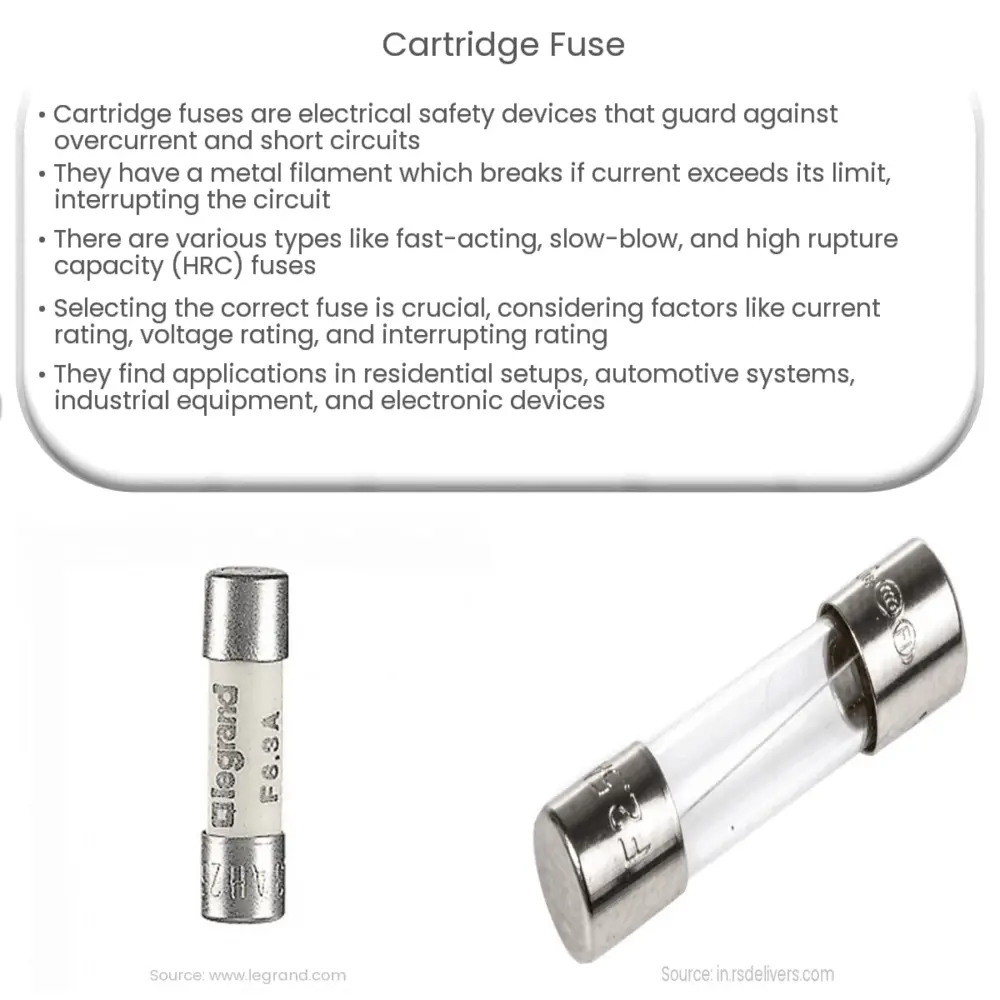A cartridge fuse is a cylindrical safety device that interrupts electrical circuits when current exceeds a specified value, protecting against overcurrent and short circuits.

Cartridge Fuse: A Comprehensive Guide
Cartridge fuses are a type of electrical safety device that protect electrical circuits from overcurrent or short circuit situations. They come in a variety of sizes and ratings, designed to handle different levels of electrical current. In this article, we will explore the workings of a cartridge fuse, its various types, and the importance of selecting the right fuse for your electrical system.
What is a Cartridge Fuse?
A cartridge fuse is a cylindrical, tube-shaped device that contains a metal wire or filament. This filament is designed to melt or break when the current flowing through it exceeds a specified value. When the filament breaks, the electrical circuit is interrupted, preventing damage to the connected equipment or appliances. Cartridge fuses are typically encased in a ceramic or glass tube to provide insulation and protect the filament from external factors.
Types of Cartridge Fuses
There are several types of cartridge fuses available, each designed to cater to different applications and requirements. Some of the most common types include:
- Fast-acting fuses: These fuses are designed to quickly respond to overcurrent situations, offering immediate protection for sensitive electronic devices. Fast-acting fuses have a low melting point, which causes the filament to break rapidly when the current exceeds the fuse’s rated value.
- Slow-blow fuses: Also known as time-delay fuses, slow-blow fuses are designed to withstand short bursts of overcurrent without breaking. This makes them suitable for applications where temporary overcurrents are common, such as in motors or transformers. The filament in slow-blow fuses has a higher melting point, allowing it to handle brief overloads without interrupting the circuit.
- High rupture capacity (HRC) fuses: HRC fuses are designed to handle high-voltage and high-current applications, offering superior protection for electrical equipment. They feature a special construction that allows them to safely interrupt high levels of fault current without producing harmful arc flash or other dangerous effects.
Selecting the Right Fuse
Choosing the correct cartridge fuse for your electrical system is crucial to ensure the safety and reliability of your equipment. Here are a few factors to consider when selecting a fuse:
- Current rating: The current rating of a fuse is the maximum amount of current it can handle without breaking. It is essential to select a fuse with a current rating that matches or slightly exceeds the maximum current expected in the circuit.
- Voltage rating: The voltage rating of a fuse refers to the maximum voltage it can safely interrupt without causing damage. Always choose a fuse with a voltage rating that meets or exceeds the voltage of your electrical system.
- Interrupting rating: The interrupting rating, also known as breaking capacity, is the maximum fault current a fuse can safely interrupt without causing damage. Make sure the interrupting rating of the fuse you choose is adequate for your specific application.
In the second part of this article, we will delve deeper into the applications of cartridge fuses, installation procedures, and troubleshooting common issues.
Applications of Cartridge Fuses
Cartridge fuses are widely used in various industries and applications due to their versatility and reliability. Some common applications include:
- Residential and commercial electrical systems: Cartridge fuses are commonly used in homes, offices, and commercial establishments to protect electrical circuits and appliances from overcurrent and short circuits.
- Automotive systems: In automotive applications, cartridge fuses help protect critical systems such as lighting, engine management, and infotainment from electrical faults.
- Industrial equipment: Cartridge fuses are an essential component in industrial machinery, ensuring the safe operation of motors, transformers, and other electrical equipment.
- Electronic devices: Fast-acting cartridge fuses are often used in sensitive electronic devices, providing protection against sudden current surges that could damage delicate components.
Installation Procedures
Installing cartridge fuses is a relatively simple process, but it’s essential to follow the appropriate steps and safety precautions:
- Power off: Before working with any electrical system, always ensure that the power is turned off to prevent the risk of electric shock.
- Identify the fuse holder: Locate the fuse holder in your electrical panel or device. Fuse holders may be labeled with their voltage and current ratings for easy identification.
- Select the correct fuse: Choose a cartridge fuse with the appropriate current, voltage, and interrupting ratings for your specific application, as discussed in the first part of this article.
- Insert the fuse: Carefully insert the cartridge fuse into the fuse holder, ensuring that it is fully seated and secure. Do not use excessive force, as this could damage the fuse or fuse holder.
- Restore power: Once the fuse is installed, turn the power back on and test the system to ensure proper operation.
Troubleshooting Common Issues
While cartridge fuses are generally reliable, they can sometimes fail or become damaged. Here are some common issues and troubleshooting tips:
- Blown fuse: If a fuse blows repeatedly, it may be an indication of an underlying problem in the circuit, such as a short circuit or an overloaded component. Identify and address the root cause before replacing the fuse.
- Incorrect fuse rating: Using a fuse with an incorrect current, voltage, or interrupting rating can lead to inadequate protection or frequent fuse failures. Ensure that you are using the correct fuse for your application.
- Physical damage: Check for signs of physical damage, such as a cracked or broken casing, which could compromise the fuse’s integrity. Replace any damaged fuses immediately.
In conclusion, cartridge fuses are a vital component in various electrical systems, providing essential protection against overcurrent and short circuit situations. By understanding the different types of cartridge fuses and selecting the appropriate fuse for your application, you can ensure the safety and reliability of your electrical system.

